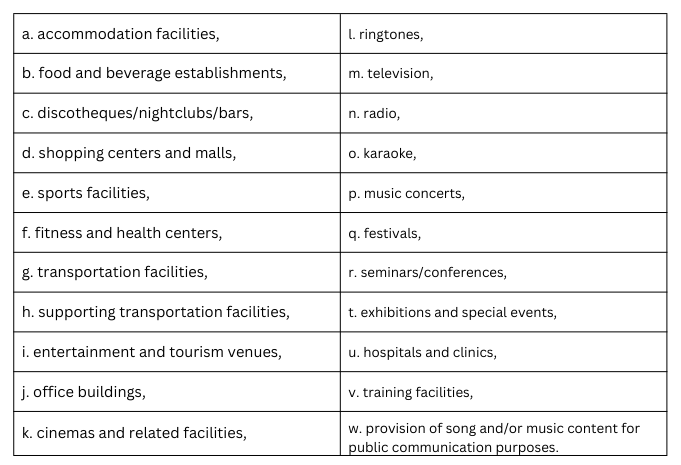Minister of Law Regulation 27/2025: New Rules on Music Royalties and Key Differences from Minister of Law and Human Rights Regulation 9/2022

The issuance of MOLR 27/2025 introduces a new framework for managing music and/or song royalties in Indonesia, while simultaneously revoking MOLR 9/2022. Through this regulation, the government strengthens the LMKN’s role as the central management body, explicitly distinguishes between royalty obligations for analog and digital users, tightens the operational budget limits, and expands the audit scope with stricter consequences, including revocation of LMK operational permits. Although this new implementing regulation provides greater legal certainty for businesses, it still leaves open questions, particularly regarding the mechanism for detecting music use and whether payment obligations will apply retrospectively or only prospectively.
The issue of music royalties has long been a matter of debate among businesses and the public. In response, the Ministry of Law of the Republic of Indonesia recently issued Regulation Number 27 of 2025 concerning the Implementation of Government Regulation Number 56 of 2021 concerning the Management of Song and/or Music Copyright Royalties (“MOLR 27/2025“). This new regulation simultaneously revokes the previously applicable Ministry of Law and Human Rights Regulation Number 9 of 2022 concerning the Implementation of Government Regulation Number 56 of 2021 concerning the Management of Song and/or Music Copyright Royalties (“MOLR 9/2022“) and introduces a more detailed legal framework for royalty payment obligations in Indonesia. Below, we outline in more detail the key updates in MOLR 27/2025.
MOLR 27/2025 as a New Roadmap for Music Royalties
Indonesia’s Copyright Law, reinforced by its implementing regulation, Government Regulation Number 56 of 2021 concerning the Management of Song and/or Music Copyright Royalties (“GR 56/2021“), already requires businesses using songs and/or music for commercial purposes to pay royalties. However, MOLR 9/2022, the implementing regulation for GR 56/2021, has been deemed inadequate in providing technical certainty. Issues such as unclear distribution mechanisms, the limited administrative role of the LMKN, and a lack of public transparency have created confusion among businesses and creators. With the enactment of MOLR 27/2025, the government seeks to address these gaps. This implementing regulation not only reaffirms the obligation to pay royalties but also refines the governance framework by strengthening the National Collective Management Institution (Lembaga Manajemen Kolektif Nasional, “LMKN“) as the central management body, explicitly classifies users into analog and digital, and clarifies distribution procedures. For business actors, MOLR 27/2025 serves as a more comprehensive roadmap than its predecessor.

Major Updates in MOLR 27/2025
- Who Is Required to Pay Royalties
Although the distinction between analog and digital use was already recognized in GR 56/2021, MOLR 27/2025 provides the first detailed elaboration by expressly categorizing commercial users into two groups, analog users and digital users, and setting out in detail the types of activities included in each category, as follows:1- Analog Users

- Digital Users
- audio/video streaming;
- audio/video downloading;
- simulcast/webcast;
- video on demand/over the top;
- online/web radio; and
- live event streaming.
- Analog Users
- Royalty Collection and Distribution
Under MOLR 9/2022, royalties were collected by the LMKN and distributed through the Collective Management Institution (Lembaga Menajemen Kolektif, “LMK”). For creators or rights holders not affiliated with any LMK, their royalties remained subject to collection, with the LMKN directly responsible for the process. While these provisions remain applicable, however, MOLR 27/2025 provides further elaboration.Through MOLR 27/2025, the government expands the scope of collection by explicitly including analog and digital users, and even opens up the possibility of cross-border collection through collaborations with foreign collective management organizations and digital platforms.2 Royalty distribution is now also possible for creators or rights holders who are not members of any LMK through a claim and verification mechanism.3 - Position of the LMKN
Based on MOLR 9/2022, the LMKN primarily served as an administrative body and relied on LMKs for royalty distribution. Conversely, through MOLR 27/2025, the LMKN now holds a much stronger role, including managing royalty collections, establishing LMK codes of ethics, determining royalty payment calculation methods, and even recommending LMK operational permits.4 LMKN is also required to manage all transactions through a single official account accessible to all LMKs5 , thus minimizing the potential for duplication or misuse. - Operational Fund Limit
Based on MOLR 9/2022, operational funds (including operational costs of the LMKN) could reach up to 20% of annual royalty collections. However, now, under MOLR 27/2025, LMKN operational funds are limited to 8% of annual royalties collected, with expenditures required to be outlined in the annual budget plan jointly approved in a plenary session.6 - Revocation of LMK Operational Permits
In terms of oversight, both MOLR 9/2022 and MOLR 27/2025 authorize the Minister to revoke the business licenses of LMKs that violate regulations. The reasons for revocation largely remain the same, ranging from unlawful royalty collection, failure to distribute royalties, and failure to conduct audits, to violations of the code of ethics.However, MOLR 27/2025 adds a new obligation: LMKs are required to upload creator and copyright holder data to the Central Music/Song Database.7 Failure to comply with this obligation within one year may result in the immediate revocation of the LMK’s operational permits.8Following the revocation, the LMK is prohibited from collecting or distributing royalties. The LMK is given only 30 days to distribute any remaining royalties collected and to transfer all user data to the LMKN. After that, the LMKN will be responsible for ensuring that the rights of creators and copyright holders remain properly distributed.9
- Audit Obligations
Both MOLR 9/2022 and MOLR 27/2025 require annual public audits, the results of which must be reported to the Minister and published to the public. However, MOLR 27/2025 expands the scope of audits, covering not only routine financial reports but also the use of reserve funds.10 The consequences are also stricter: failure to conduct or report an audit can result in immediate revocation of the LMK’s operational permits.11

Gaps and Open Questions
While MOLR 27/2025 provides greater technical clarity compared to MOLR 9/2022, several practical issues remain unanswered.
One of the most frequently asked questions by businesses is how the detection of music use in commercial spaces will be carried out. Unfortunately, MOLR 27/2025 does not specify whether the LMKN, LMK, or the government will use specific systems, monitoring tools, or industry collaboration mechanisms to ensure compliance. Without clarity regarding detection methods, businesses are concerned that this obligation could lead to uncertainty in practical implementation.
Another unresolved issue is the nature of the royalty payment obligation itself: whether it applies retrospectively or only prospectively. The government, through MOLR 27/2025, only reaffirms the obligation to collect, manage, and distribute royalties, but does not provide guidance on whether this obligation should be calculated from the start of business activities (retrospective) or only from the time the collection mechanism takes effect (prospective). This gap is significant, as it can have a material impact on the financial burden of businesses, especially those that have operated for years without ever being charged royalties.
Practical Steps for Businesses
For businesses, the enactment of MOLR 27/2025 marks a new chapter that cannot be ignored. Businesses should be aware that royalty obligations apply not only to music used in physical or analog settings but also to digital use, which is now expressly regulated under MOLR 27/2025. Businesses should also ensure that payments are only made through the official accounts of the LMKN. Payment documentation must be meticulously maintained, and internal record-keeping systems must also be strengthened to anticipate future audits or inspections.
Engaging legal counsel is also crucial, not only to ensure compliance with the new regulations but also to design risk mitigation strategies for potential future changes. This is especially relevant considering that the government has included a revision to the Copyright Law in the 2025 National Legislation Program (Prolegnas), which could further shape the regulatory landscape of royalties in Indonesia.
Understand the risks and implications of MOLR 27/2025 on your business model. Our Intellectual Property Team at ADCO Law is ready to assist you in diligently carrying out these legal obligations.
***
About ADCO Law:
ADCO Law is a law firm that offers clients a wide range of integrated legal services, including commercial transactions and corporate disputes in a variety of industry sectors. Over the course of more than a decade, we have grown to understand our clients’ industries and businesses as well as the regulatory aspects. In dealing with business dynamics, we provide comprehensive, solid legal advice and solutions to minimize legal and business risks.
From Upstream to Downstream, We Understand Your Industry. In complex transactions and certain cases, we actively engage with financial, tax, and environmental specialists, accountants, and law firms from various jurisdictions to add value to our clients. Our strong relationships with Government agencies, regulators, associations, and industry stakeholders ensure that our firm has a holistic view of legal matters.
ADCO Law is a Proud Member of the Alliott Global Alliance (AGA) in Indonesia. Founded in 1979, AGA is one of the largest and fastest-growing global multidisciplinary alliances, with 215 member firms in 95 countries. As a law firm, we also believe in regeneration. To stay abreast of business changes and stay relevant, our formation of lawyers is comprised of the top graduates from Indonesian and international law schools.

